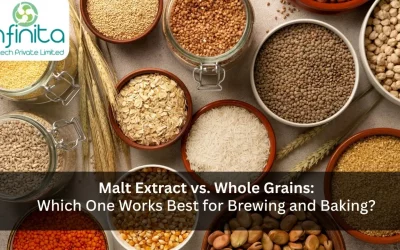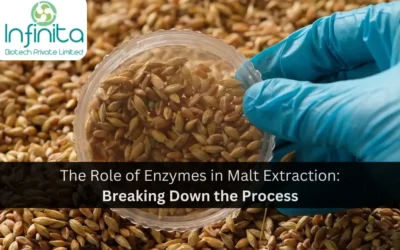Malt is germinated cereal grain that has been dried in a process known as “malting”. Malted barley, or ‘Malt’ as it is most commonly known, is a wonderful package of starch, enzymes, protein, vitamins, and minerals plus many other minor constituents that provide the brewer and distiller with their main raw material.
The grains are made to germinate by soaking in water and are then halted from germinating further by drying with hot air. Malting grains develop the enzymes required for modifying the grain’s starches into various types of sugar, including monosaccharide glucose, disaccharide maltose, trisaccharide malt triose, and higher sugars called maltodextrins.
It also develops other enzymes, such as proteases, which break down the proteins in the grain into forms that can be used by yeast. Depending on when the malting process is stopped, one gets a preferred starch to enzyme ratio and partly converted starch into fermentable sugars. Malt also contains small amounts of other sugars, such as sucrose and fructose, which are not products of starch modification but were already in the grain. Further conversion to fermentable sugars is achieved during the mashing process.
Malted grain is used to make beer, whiskey, malted milkshakes, malt vinegar, confections such as Maltesers and Whoppers, flavoured drinks such as Horlicks, Ovaltine, and Milo, and some baked goods, such as malt loaf, bagels, and rich tea biscuits. Malted grain that has been ground into a coarse meal is known as “sweet meal”. Various cereals are malted, though barley is the most common. A high-protein form of malted barley is often a label-listed ingredient in blended flours typically used in the manufacture of yeast bread and other baked goods.
60-65% of the weight of malt is un-degraded starch and malt contains all the key enzymes for starch degradation during the mashing stage of both the brewing and distilling process. These enzymes produce fermentable sugars to supplement the other key nutrients for yeast growth that malt provides. These include amino acids, vitamins, and minerals.
The malting process consists of 4 stages steeping, germination, kilning and roasting.
1. Steeping
The basic malting process, although more of an exact science today than when man first dipped baskets of grain into open wells in Mesopotamia 5,000 years ago to prepare it for brewing, remains a three-step process: steeping, germination, and drying.
During steeping water is absorbed by the raw barley kernel and germination begins. Steeping starts with raw barley that has been sorted and cleaned, then transferred into steep tanks and covered with water. For the next 40-48 hours, the raw barley alternates between submerged and drained until it increases in moisture content from about 12% to about 44%. The absorbed water activates naturally existing enzymes and stimulates the embryo to develop new enzymes. The enzymes break down the protein and carbohydrate matrix that encloses starch granules in the endosperm, opening up the seed’s starch reserves, and newly developed hormones initiate growth of the acrospires (sprout).
Steeping is complete when the barley has reached a sufficient moisture level to allow a uniform breakdown of the starches and proteins. One visual indicator that the maltster uses to determine the completion of steeping is to count the percentage of kernels that show “chit”. Raw barley that has been properly steeped is referred to as “chitted” barley”, the “chit” being the start of the rootlets that are now visibly emerging from the embryo of the kernel.
2. Germination
Germination is the ‘control’ phase of malting. It continues for a further 4-5 days depending on the product type being made. The germinating grain bed is kept at a temperature and oxygenated by providing a constant flow of humidified air through the bed at specific temperatures. The grain is turned regularly to prevent rootlets matting and to maintain a loosely packed grain bed. The maltster manipulates the germination conditions to vary the type of malt being manufactured.
3.Kilning
Kilning, the third phase of malting, dries the grain down to 3-5% moisture and arrests germination. Large volumes of hot air are blown through the grain bed. By varying air flows and kiln temperatures, malts of different colours can be produced with varying flavour profiles. At the end of kilning the malt is cooled and the tiny rootlets removed before analysis and storage. The final malt is analysed extensively according to malt type and customer profile. The malt may be dispatched in bags, in containers or in bulk.
4. Roasting
Roasting is done in 4 distinct stages: steeping, germinating, roasting and cooling. At GWM Malt, grain spends 34-46 hours in steep tanks where we aim for target moisture of 42-44%. The grain is transferred to germination which lasts for around 4 weeks. This is a semi-continuous moving batch germination process. Once germination is complete, the green malt is then transferred to the roasting drum.
The roasting takes place in two roasting drums. The average roasting time is 2 ½ – 3 hours with air on temperatures of up to 460˚C. Our roasters take a batch size of 2.4 – 3.5 tonnes. The roasted malt is then transferred to the cooler and spends 35 – 60 minutes there in order to drop the temperature to <15˚C and fix the colour and flavour compounds. The malt is analysed before storage and thereafter awaits dispatch to our customers.
Benefits Of Malt:
1. Rich In B Vitamins
As a rich source of B vitamins, malt extract may increase the B-vitamin content of the beverages it’s used in — including thiamine, riboflavin, niacin, folate, and vitamin B-6. The amount may vary depending on the malt beverage you’re drinking, however. B vitamins are necessary for metabolising the carbohydrates, protein, and fat in food into energy. They also help regulate appetite, promote good vision and keep your skin healthy.
2. Source Of Essential Amino Acids
Malt extract is a source of essential amino acids, which your body needs to make the proteins. Although some malt extract beverages are not a significant source of protein, they may help provide a small amount of these essential nutrients, boosting your intake.
3. Good For Your Bones
Good nutrition is important for bone health. Some malt extract beverages may not be a significant source of the nutrients your bones need for good health, but they can help boost your intake. In addition to calcium, these drinks may also contain phosphorus and magnesium, also important minerals that help keep your bones healthy and strong. All three minerals make up the primary structure of your bones, while magnesium is also needed to regulate the hormones responsible for mineral metabolism.
4. Things To Consider
While malt extract beverages offer some nutritional benefits, they may not be a significant source of many of these health-promoting nutrients. It’s OK to include such beverages in your regimen, but they should be consumed as part of an overall healthy diet so your body gets all the nutrients it needs from a variety of sources. Even the malt extract beverages promoted as being a rich source of nutrients are still high in sugar and low in protein.







